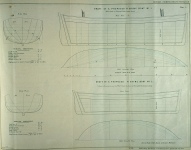Herring Home | Fishing for herring | Next
The Washington Report and the introduction of decking
Many small boats were lost at sea during the early part of the 19th century. This led to pressure for improvement in the design and standards of small fishing boats. In August 1848 there was a terrible storm in the Moray Firth. Over 100 boats were lost all along the coast from Wick to Stonehaven, and 100 men died. Following this storm, Captain Washington was asked by the House of Commons to conduct an enquiry into the disaster. He produced a report entitled 'Report on the loss of life, and damage caused to fishing boats on the East Coast of Scotland, in the gale of 19th August 1848. His two main conclusions were that there was a shortage of good harbours accessible at all states of the tide, and that fishing boats were poorly designed. The report said that decked vessels should be introduced. It also suggested that boats should have flat floors and a deep keel for stability.

After the Washington Report the Fishery Board encouraged the use of decked vessels. The first full-decked vessel was built in Eyemouth in 1856. In 1860 the baldie was introduced. Fishermen were not keen to use the decked boats to begin with as they preferred the undecked boats because there was more room to work and they held more fish. However, by the later 1860s decked boats became generally accepted.
As decked boats became more widespread, there was also a trend towards larger vessels to compensate for the space lost in decking the vessel. By this time, new boats were regularly being built with a small forecastle in the bow. This gave covered bunks, and so provided shelter to the fishermen. In 1879 a new boat called the zulu was produced.